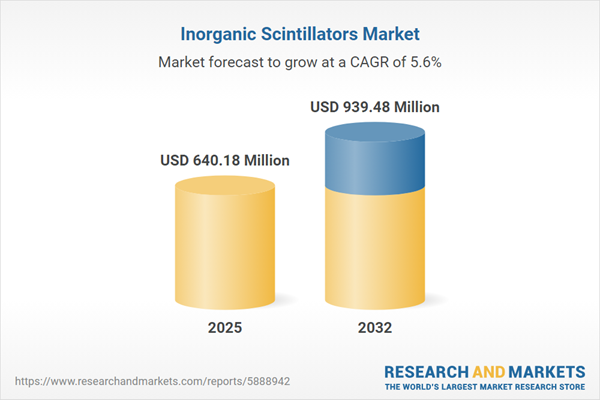Speak directly to the analyst to clarify any post sales queries you may have.
Inorganic scintillators play a foundational role in ensuring operational precision and regulatory compliance across sectors reliant on advanced detection and imaging. Serving as a technological cornerstone, these materials underpin initiatives in sectors where quality assurance and monitoring are paramount.
Market Snapshot: Inorganic Scintillators Market
The inorganic scintillators market is witnessing steady and reliable growth, valued at USD 605.59 million in 2024 and set to reach USD 640.18 million by 2025, with forecasts indicating expansion to USD 939.48 million by 2032. This uptick is driven by rising demand across high-precision medical imaging, the strengthening of security infrastructure, and increased research-focused applications. Advances in crystal, fiber, and ceramic scintillator technologies are catalyzing greater system adaptability, longevity, and responsiveness to evolving regulatory requirements. Investment in continuous innovation emphasizes the market’s position as an enabler for critical reliability and compliance within sensitive industrial environments.
Scope & Segmentation
- Material Types: Bismuth Germanate, Cesium Iodide, Gadolinium Aluminum Gallium Garnet, Lanthanum Bromide, and Sodium Iodide are principal materials. Each choice is engineered for stringent detection, supporting robust safety and operational standards in healthcare, defense, security, and research.
- Applications: Inorganic scintillators are integral to computed tomography, X-ray diagnostics, energy exploration, cargo and baggage inspection, and nuclear facility oversight. These domains require accurate process monitoring to align with strict regulatory guidance.
- End Users: The primary adopters are government agencies, diagnostic centers, energy and mining companies, and research institutions. These organizations regularly invest in sophisticated monitoring for enhanced management and comprehensive risk mitigation.
- Form Factors: Products are available as blocks, polycrystalline and monocrystalline crystals, fibers, and thin films, enabling integration within modular and space-constrained device architectures for greater system versatility.
- Regions: The Americas, Europe, Middle East & Africa, and Asia-Pacific exhibit distinct technology adoption rates and regulatory priorities, informing purchasing and deployment decisions across global markets.
- Profiles Covered: Compagnie de Saint-Gobain S.A., Hamamatsu Photonics K.K., Shanghai Cino Corp., CRYTUR, Scintacor Ltd., Scionix Holland B.V., Eljen Technology LLC, Opto Materials S.r.l., Radiation Monitoring Devices Inc., and Crystal Photonics Inc. are established suppliers supporting seamless product delivery and technical support across supply chains.
Key Takeaways for Senior Leaders
- Recent developments in advanced scintillator compositions are enabling greater precision, directly supporting sensitive healthcare and national security applications.
- Supplier and institutional collaboration is driving rapid innovation in fiber and ceramic scintillator technologies, positioning organizations to efficiently address evolving compliance demands.
- Regional manufacturing strategies and vertically integrated sourcing offer enhanced supply chain resilience by limiting exposure to global disruptions and logistics uncertainties.
- Wide-ranging form factor options facilitate rapid system upgrades, allowing for the adoption of new materials without costly redesign or process interruption.
- Improvements in photodetector integration and signal processing elevate data integrity, supporting safety measures and research initiatives across multiple industries.
- Specialized materials tailored to unique needs, including nuclear facility safety and advanced medical diagnostics, expedite compliance and system implementation in highly regulated environments.
Tariff Impact Analysis
As U.S. tariff policies evolve in 2025, organizations are adapting procurement strategies to manage costs and maintain continuity. Emphasis on strategic regional partnerships and long-term sourcing arrangements is helping organizations navigate volatility. Enhanced investment in local manufacturing further supports procurement reliability and reinforces cross-border supply stability.
Methodology & Data Sources
This report is built on extensive input from industry leaders, procurement specialists, technical forums, patent evaluations, site inspections, and independent regulatory audits, resulting in guidance that addresses both tactical and strategic needs in the inorganic scintillators market.
Why This Report Matters
- Procurement and compliance teams gain clear direction on technology selection and effective adaptation to regulatory shifts in the inorganic scintillators sector.
- Executive leadership benefits from insights into trend adoption and the drivers of innovation, strengthening operational and strategic decision-making across regions.
- The report enables proactive risk management, supply chain resilience, and sustained compliance in a dynamic technological and regulatory environment.
Conclusion
The analysis provides senior leaders with an informed perspective to refine procurement and risk strategies. Applying these insights supports compliance, operational reliability, and competitiveness as industry conditions evolve.
Additional Product Information:
- Purchase of this report includes 1 year online access with quarterly updates.
- This report can be updated on request. Please contact our Customer Experience team using the Ask a Question widget on our website.
Table of Contents
3. Executive Summary
4. Market Overview
7. Cumulative Impact of Artificial Intelligence 2025
Companies Mentioned
The companies profiled in this Inorganic Scintillators market report include:- Compagnie de Saint-Gobain S.A.
- Hamamatsu Photonics K.K.
- Shanghai Cino Corp., Ltd.
- CRYTUR spol. s r.o.
- Scintacor Ltd.
- Scionix Holland B.V.
- Eljen Technology, LLC
- Opto Materials S.r.l.
- Radiation Monitoring Devices, Inc.
- Crystal Photonics, Inc.
Table Information
| Report Attribute | Details |
|---|---|
| No. of Pages | 186 |
| Published | November 2025 |
| Forecast Period | 2025 - 2032 |
| Estimated Market Value ( USD | $ 640.18 Million |
| Forecasted Market Value ( USD | $ 939.48 Million |
| Compound Annual Growth Rate | 5.6% |
| Regions Covered | Global |
| No. of Companies Mentioned | 11 |









